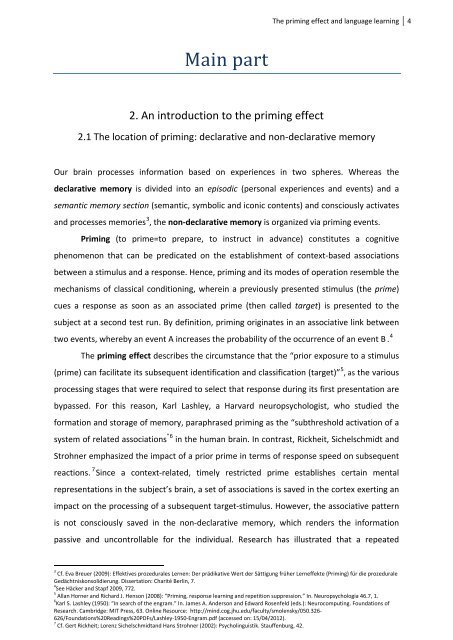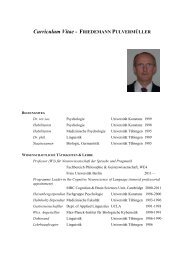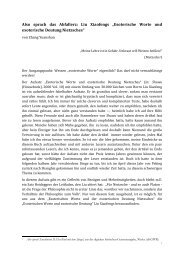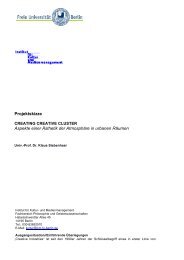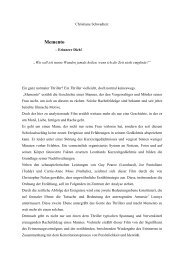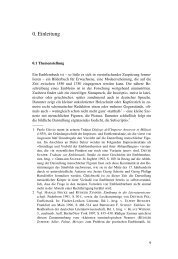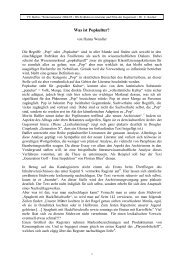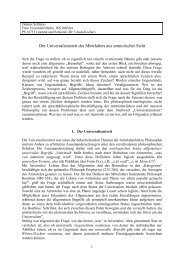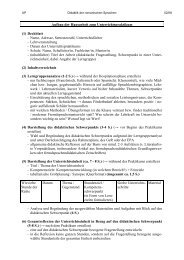3. Priming in action - Fachbereich Philosophie und ...
3. Priming in action - Fachbereich Philosophie und ...
3. Priming in action - Fachbereich Philosophie und ...
Create successful ePaper yourself
Turn your PDF publications into a flip-book with our unique Google optimized e-Paper software.
Ma<strong>in</strong> part<br />
2. An <strong>in</strong>troduction to the prim<strong>in</strong>g effect<br />
The prim<strong>in</strong>g effect and language learn<strong>in</strong>g 4<br />
2.1 The location of prim<strong>in</strong>g: declarative and non-declarative memory<br />
Our bra<strong>in</strong> processes <strong>in</strong>formation based on experiences <strong>in</strong> two spheres. Whereas the<br />
declarative memory is divided <strong>in</strong>to an episodic (personal experiences and events) and a<br />
semantic memory section (semantic, symbolic and iconic contents) and consciously activates<br />
and processes memories 3 , the non-declarative memory is organized via prim<strong>in</strong>g events.<br />
<strong>Prim<strong>in</strong>g</strong> (to prime=to prepare, to <strong>in</strong>struct <strong>in</strong> advance) constitutes a cognitive<br />
phenomenon that can be predicated on the establishment of context-based associations<br />
between a stimulus and a response. Hence, prim<strong>in</strong>g and its modes of operation resemble the<br />
mechanisms of classical condition<strong>in</strong>g, where<strong>in</strong> a previously presented stimulus (the prime)<br />
cues a response as soon as an associated prime (then called target) is presented to the<br />
subject at a second test run. By def<strong>in</strong>ition, prim<strong>in</strong>g orig<strong>in</strong>ates <strong>in</strong> an associative l<strong>in</strong>k between<br />
two events, whereby an event A <strong>in</strong>creases the probability of the occurrence of an event B . 4<br />
The prim<strong>in</strong>g effect describes the circumstance that the “prior exposure to a stimulus<br />
(prime) can facilitate its subsequent identification and classification (target)” 5 , as the various<br />
process<strong>in</strong>g stages that were required to select that response dur<strong>in</strong>g its first presentation are<br />
bypassed. For this reason, Karl Lashley, a Harvard neuropsychologist, who studied the<br />
formation and storage of memory, paraphrased prim<strong>in</strong>g as the “subthreshold activation of a<br />
system of related associations ”6 <strong>in</strong> the human bra<strong>in</strong>. In contrast, Rickheit, Sichelschmidt and<br />
Strohner emphasized the impact of a prior prime <strong>in</strong> terms of response speed on subsequent<br />
re<strong>action</strong>s. 7 S<strong>in</strong>ce a context-related, timely restricted prime establishes certa<strong>in</strong> mental<br />
representations <strong>in</strong> the subject’s bra<strong>in</strong>, a set of associations is saved <strong>in</strong> the cortex exert<strong>in</strong>g an<br />
impact on the process<strong>in</strong>g of a subsequent target-stimulus. However, the associative pattern<br />
is not consciously saved <strong>in</strong> the non-declarative memory, which renders the <strong>in</strong>formation<br />
passive and uncontrollable for the <strong>in</strong>dividual. Research has illustrated that a repeated<br />
3<br />
Cf. Eva Breuer (2009): Effektives prozedurales Lernen: Der prädikative Wert der Sättigung früher Lerneffekte (<strong>Prim<strong>in</strong>g</strong>) für die prozedurale<br />
Gedächtniskonsolidierung. Dissertation: Charité Berl<strong>in</strong>, 7.<br />
4<br />
See Häcker and Stapf 2009, 772.<br />
5<br />
Allan Horner and Richard J. Henson (2008): “<strong>Prim<strong>in</strong>g</strong>, response learn<strong>in</strong>g and repetition suppression.” In. Neuropsychologia 46.7, 1.<br />
6<br />
Karl S. Lashley (1950): “In search of the engram.” In. James A. Anderson and Edward Rosenfeld (eds.): Neurocomput<strong>in</strong>g. Fo<strong>und</strong>ations of<br />
Research. Cambridge: MIT Press, 6<strong>3.</strong> Onl<strong>in</strong>e Resource: http://m<strong>in</strong>d.cog.jhu.edu/faculty/smolensky/050.326-<br />
626/Fo<strong>und</strong>ations%20Read<strong>in</strong>gs%20PDFs/Lashley-1950-Engram.pdf (accessed on: 15/04/2012).<br />
7<br />
Cf. Gert Rickheit; Lorenz Sichelschmidtand Hans Strohner (2002): Psychol<strong>in</strong>guistik. Stauffenburg, 42.


